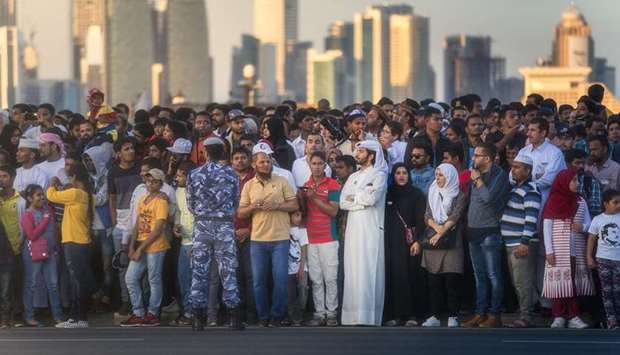The Planning and Statis-tics Authority (PSA) an-nounced the results of the General Census of Population, Housing and Establishments 2020, during a ceremony held at the PSA building on Wednesday.
The results show that total population in the Census 2020 rose by approximately 1,147,000 compared to Census 2010, to reach approximately 2,846,000, which represents an increase of 67.5% over the 2010 census.
The annual growth rate be-tween the 2010 and 2020 censuses was 5.3%, with a decrease in the annual rate compared to what it was between the 2004 and 2010 censuses, which was 14.8%. The increase in the male population represented the largest percentage of the increase in population numbers, reaching 65.4%, while females accounted for 34.6% of the total increase.
The results also showed an increase in the population of all age groups in the 2020 census than it was in the 2010 census.
The age group (30-34) topped the list of categories with the highest increase in numbers, with an increase of approximately (219) thousand people.
On the other hand, Doha Municipality had the highest population density rate of 5,344.1 people per square kilometre of the area of the municipality, after it registered only 3,590.9 people in Census 2010.
Despite this, its percentage of the total population decreased from 46.9% in 2010 to 41.7% in 2020.
Umm Slal Municipality main-tained the second place in the ranking of population density by municipality with 471.0 people, while Al Rayyan Municipality ranked third with a population density of 337.5 people.
With regard to the educational attainment 10+, the percentage of Qataris who attained a secondary certificate or higher has increased at the expense of the least educated, reaching 29.2% of the total number of Qataris (10+) compared to 27.9% in the 2010 census.
The percentage of Qataris holding a university degree or higher reached 33.9%, compared to 20.3% in Census 2010.
According to the results, the percentage of economically active Qataris (15+) who work for wages increased slightly by 0.6% at the expense of those with other practical cases between the 2010 and 2020 censuses, reaching 97.7% in the 2020 census, after it was 97.1% in the 2010 census. The rate of increase for paid Qataris between the two censuses was 60.1%. As for the economically active non-Qataris (15+), the percentage of those who work for wages decreased slightly to 99.6%, after it was 99.8% in Census 2010, while the percentage of employers among them increased to 0.3%, after it was 0.1% in the 2010 census.
Economically active Qataris mostly work in public administration and defence activities with a rate of 53.5%, followed by education with 12.3%, then health and social work with 6.2%. As for non-Qataris, they mostly work in the construction activity by 34.1%, followed by the wholesale and retail trade and vehicle repair activity with 12.5%, then the administrative and support services activities with 9.6%. The results also showed an increase in the percentage of Qataris working in the mixed sector, reaching 34% in Census 2020, after it was 9% in Census 2010 of the total workers in the mixed sector.
Non-Qataris accounted for more than 98% of the workers in the private sector, domestic, diplomatic /international/ regional. The results of Census 2020 showed that 78.9% of the total jobs are in the private sec-tor, followed by the domestic sector with 8.2%, and then the government sector with 8.1%.The results showed an increase in the percentage of jobs in the private sector by 4.0%, while the percentage of jobs in the government sector increased by 0.4%. With regard to buildings, the results showed an increase in the number of buildings by 49.7%, compared to Census 2010, reaching approximately (222.7) thousand buildings.
The percentage of completed buildings in Al Rayyan Municipality also increased than those in Doha Municipality.
The percentage of buildings located in the municipalities of Doha and Al Rayyan in Census 2020 increased 61.9% of the total buildings in the country, after it constituted 73.4% in Cen-sus 2010. With regard to housing units, the results showed an increase by 55.8% between the 2010 and 2020 censuses, reach-ing approximately (403.8) thou-sand in Census 2020.
Apartments constituted 53.1% of the total housing units in the country, with Doha municipality having 67.7% of them.
Meanwhile, the number of business establishments in-creased by 130.6% to reach approximately (71,2 thousand) in Census 2020.

